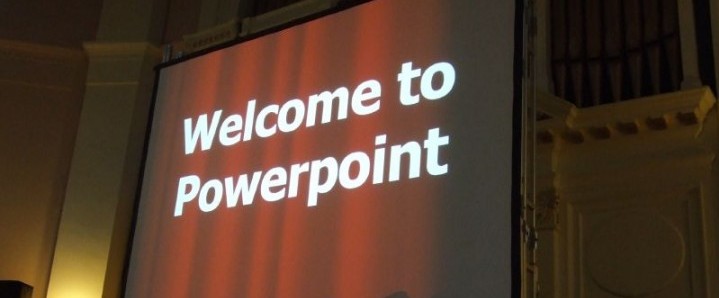
According to some sources, more than 30 million business presentations are created each day.
And you know what? Most of them are terrible. We’ve all sat through the proverbial terrible presentation with no purpose, nothing memorable, no clear action items, too many slides, the monotonous drone of the boring presenter. There is a reason business presentations get lampooned all the time. How does something become a cliché?
The PowerPoint presentation is an abused and overused method of communication. But when it is done well, the results can be remarkable, because, frankly, the bar is set really low. It’s pretty easy to impress.
So, in my effort to help you impress, here is an important mind set to carry with you when you are preparing for your next business presentation.
Your slides can only hurt you. They represent nothing but risk, nothing but downside.
It is true, and I can prove it to you.
Imagine that I walk into the room, and speak a great presentation… I am articulate and clear and smooth. I look people in the eye. I get to the point quickly. I do everything correctly, with one exception: I have put a terrible deck of slides on the screen behind me. Just imagine a great presenter with a terrible slide deck. That terrible deck will measurably hurt your perception of that otherwise great performance.
Now imagine the opposite. Imagine that I walk into the room and speak a terrible presentation. I am monotonous. I mumble. I don’t look anyone in the eye. I don’t get to the point. I am awful. But on the screen behind me, I put up the world’s most beautiful, creative, clear, and powerful slide deck. It is a perfect deck. But my perfect deck will never cause you to ignore my otherwise terrible speaking performance.
This means that a terrible deck will hurt an otherwise good presentation. A wonderful deck will not save a terrible presentation. In other words, slides can only hurt you, they cannot save you, and therefore they are nothing but risk.
How do you manage that risk? Simple. Your goal with your slides should be to give your audience nothing to be distracted by. Your goal with your slides should be simplicity, clarity and consistency. Every slide should have a purpose. Complete the following sentence: I am including this slide because… If you don’t have a good answer to that one, take the slide out. And then complete this sentence: The key message on this slide is… If you can’t complete that sentence simply, then your slide is too complicated.
Keep your slides in perspective. Make sure they don’t hurt you, and you are halfway home.
Good luck.






This is an excellent article that is true. Less is More and a well developed PowerPoint should enhance and reinforce the points that a speaker presents. I personally love designing PowerPoints, but I’ve learned that the love for design does not mean it is relevant or necessary. I recently attended a workshop on Engaging Tips during Training and the PowerPoint that was used was excellent. It was simple, clear and didn’t take away from the presenter. I agree, these great PowerPoints are rare, but when you see a good one, you know it. Take note and follow suit.
Thanks for your comment, Jackie! We appreciate it. Glad to hear you found a good example of a PowerPoint. Simplicity and clarity are definitely key to a good slide deck.